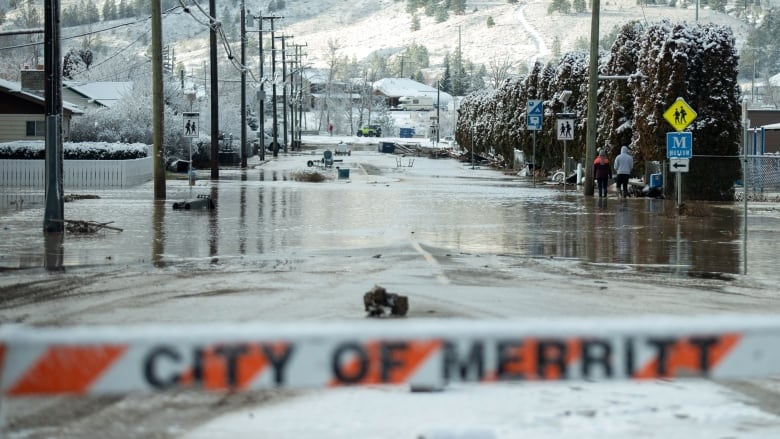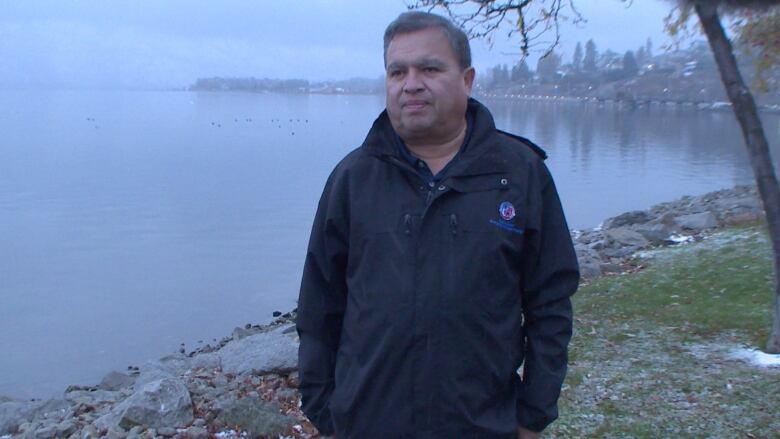Indigenous communities hit hard by B.C. floods say they received no warning, are getting little help
B.C. has not used the Alert Ready technology since it became available in 2018

The rains had been torrential for more than 12 hours when Cook's Ferry Indian Band Chief Councillor Christine Minnabarriet looked outher window and sensed something was wrong.
Driving out to nearby Highway 8, Minnabarriet saw the Nicola River was level with the roadand the water was washing right over it in some places.
Her concerns confirmed, Minnabarrietwent back to her community near Spences Bridge,northwest of Merritt,and started tellingmembers to leave.
There had been no alarm or text message alert she was her community's warning system.
By the time she got back to her office, a group call had been arranged with Emergency Management B.C., but that was hours after she'd realized the waters weretoo high and had warned people to leave.

As the province cleans up from what was some of the worst flooding and mudslidesin B.C. history, many have criticized the provincial government's lack of warning to drivers and residents in hard-hit areas.
B.C. has never used the straight-to-your-cellphone emergency communication systemknown as Alert Ready, though it'sbeen available since 2018.
Now, at least three Indigenous communities affected by the flooding are adding their voices to the chorus of those calling for more warning and better communication about evacuations and available assistance.
"B.C. dropped the ball by not contacting Indigenous communities," First Nations Leadership Council member Robert Phillips said.
"As soon as Emergency Management B.C. sees the situation that's happening, they should be calling the First Nations as well as First Nations Emergency Management Services Society," he said.
No call
Coldwater Indian Band Chief Lee Spahan was also left scrambling lastMonday. Band council members fled as flooding overwhelmed their offices in downtown Merritt.
"We never received no call," Spahan said.
The entire city of Merritt, population 7,000, was ordered to evacuate last Monday after flooding caused the failure of the municipality's wastewater treatment plant.
Spahan says he is still searching for help.
"No information is being communicated. That is totally unacceptable. We're being ignored. We're being pushed aside. We're not getting proper consultation with the city of Merritt," he said. "Band members are not being heard or being respected, and that is a huge frustration."
While Merritt is set to soon welcome back its citizens, it remainsunclear if the neighbouring Coldwater First Nation can do the same. Meanwhile, in the Fraser Valley, a handful ofIndigenous communitiesare hemmed in and trapped by flood waters.

AnEmergency Management B.C. (EMBC) spokesperson said the agencyconnects with local and Indigenous governments, and provides important information about weather and flood warnings.
The spokesperson said EMBC is also working with First Nations Emergency Operations Centres and the First Nations Emergency Management Society (FNESS) to respond to unmet needs related to emergency response and recovery efforts.
Provincial-federal breakdown
FNESS executive director Wayne Schnitzler said he was contacted by EMBC officials on Tuesday the day after flooding and landslides pounded British Columbia.
"We're supposed to be agency partners. To not be called right away was not very good for us moving forward," he said.
The First Nations Emergency Services Societywas originally created in 1986 to deal with forest fires. Their mandate now includes emergency services as needed.
Schnitzler said the lack of communication is a complex problem caused partlyby the involvement ofthree levels of government: A provincial agency (EMBC) that works to support municipalities and cities, while also trying to communicate with Indigenous communities, which are federal bodies.

"They're kind of not totally embraced as true partners, and that's when you get these gaps in service," he said.
"They need to fund a First Nations organization to be able to step up and do this work, and have the funding and the capacity to deliver these services without having to wait for funding, or approval from another agency."
Assembly of First Nations National Chief RoseAnne Archibald called for the federal government to immediately fund FNESS to deal with the specific needs of Indigenous communities during this crisis in a press release on Saturday.
Schnitzler saidthe FNESS previously had an emergency management department, but the federal government discontinued its funding and the department ceased operations. If it still existed, it could be on the ground right now working with Indigenous communities affected by flooding, he said.
A spokesperson with Indigenous Services Canada said itis partnering with FNESS and EMBC to support Indigenous communities during the present emergency.
The spokesperson said that a service agreement with EMBC ensures emergency management services on reserve are comparable to those available to other B.C. communities.
Picking up the pieces
After the Cook's Ferry evacuation, Minnabarriet is still dealing with the fallout.
Her members are scattered across Kamloops, Ashcroft and Cache Creek, many without emergency support. They're living with family, friends and some even in their cars.
"I expect them to start making their way back home," she said. "But there's nothing here for them."
Minnabarriet said communications are limited in Cook's Ferry because their fibre optic cable was damaged during last summer's wildfire.
And one of the community's homes is on the verge of being swallowed by the river. A few others are also at risk, she said.
EMBC is responding to questions, but without access and limited communication it's just information for now.
"So whether EMBC is helpful or not is almost a moot point for us that are in the community trying to deal with it on the ground," she said.












_(720p).jpg)


 OFFICIAL HD MUSIC VIDEO.jpg)
.jpg)



























































































